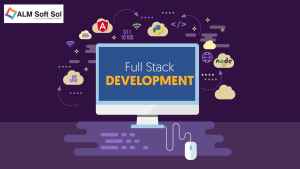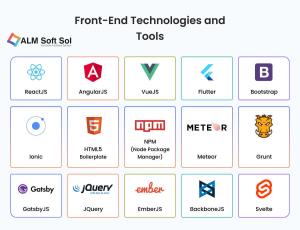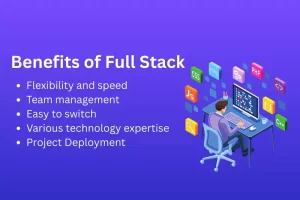Full Stack .NET: For Modern Applications
In today’s rapidly evolving software development landscape, businesses demand robust, scalable, and efficient solutions that can adapt to changing requirements. Full Stack .NET has emerged as a comprehensive development platform that addresses these needs, offering developers a unified ecosystem for building everything from web applications to cloud-native microservices. This article explores the extensive capabilities of Full Stack .NET, its practical applications, technological components, and the promising future that lies ahead.
Full Stack .NET – intro:

Full Stack .NET represents Microsoft’s complete development platform that enables developers to build applications across the entire technology stack using a single, cohesive framework. Unlike traditional development approaches that require multiple languages and frameworks for different layers of an application, .NET provides a unified development experience from the database layer to the user interface, encompassing both frontend and backend development within a single ecosystem.
The platform has evolved significantly since its inception, transitioning from the Windows-only .NET Framework to the cross-platform .NET ecosystem that supports Windows, macOS, and Linux. This evolution has transformed .NET from a Microsoft-centric technology into a truly universal development platform that competes effectively with other full-stack solutions like Node.js, Python Django, and Java Spring.
Core Technologies in the Full Stack .NET
Backend Technologies
ASP.NET Core serves as the foundation for server-side development, providing a high-performance, cross-platform framework for building web applications and APIs. It includes ASP.NET Core MVC for traditional web applications, ASP.NET Core Web API for RESTful services, and ASP.NET Core Razor Pages for page-based applications. The framework’s modular architecture and dependency injection container make it highly testable and maintainable.
Entity Framework Core acts as the primary Object-Relational Mapping (ORM) tool, enabling developers to work with databases using strongly-typed .NET objects. It supports multiple database providers including SQL Server, PostgreSQL, MySQL, SQLite, and Azure Cosmos DB, providing flexibility in data storage choices while maintaining a consistent programming model.
SignalR enables real-time web functionality, allowing server-side code to push content to clients instantly. This technology is crucial for applications requiring live updates, such as chat applications, collaborative tools, and real-time dashboards.
Frontend Technologies:

Blazor represents Microsoft’s answer to modern frontend frameworks, allowing developers to build interactive web applications using C# instead of JavaScript. Blazor Server runs on the server and updates the UI over a SignalR connection, while Blazor WebAssembly runs client-side in the browser, providing near-native performance through WebAssembly.
ASP.NET Core MVC with Razor Views provides a server-side rendering solution for traditional web applications, offering excellent SEO optimization and fast initial page loads. The Razor syntax combines HTML markup with C# code, creating a seamless development experience.
For developers who prefer JavaScript frameworks, .NET provides excellent integration with React, Angular, and Vue.js through project templates and middleware that streamline the development process.
Database and Data Technologies:
The .NET ecosystem supports a wide range of data storage solutions. SQL Server remains the flagship database with deep integration, while Azure SQL Database provides cloud-based relational database services. For NoSQL scenarios, Azure Cosmos DB offers multi-model database capabilities with global distribution.
Redis integration provides high-performance caching and session storage, while Azure Service Bus and RabbitMQ support enable robust messaging patterns for distributed applications.
Cloud and DevOps Integration:
Azure provides native cloud services optimized for .NET applications, including “Azure App Service” for hosting, Azure Functions for serverless computing, and Azure Container Instances for containerized deployments. The integration between .NET and Azure services is seamless, with built-in authentication, monitoring, and scaling capabilities.
Docker support enables containerization of .NET applications, facilitating consistent deployment across different environments. Azure DevOps and GitHub Actions provide comprehensive CI/CD pipelines specifically designed for .NET applications.
Practical Use Cases for Full Stack .NET:
Enterprise Web Applications
Large organizations frequently choose .NET for building comprehensive business applications that require robust security, scalability, and integration capabilities. These applications often involve complex business logic, extensive data processing, and integration with existing enterprise systems. The strong typing system, comprehensive security features, and excellent tooling make .NET ideal for these scenarios.
Financial institutions, healthcare organizations, and government agencies particularly benefit from .NET’s compliance capabilities and security features. The platform’s support for authentication protocols, data encryption, and audit trails makes it suitable for applications handling sensitive information.
E-commerce Platforms
.NET’s scalability and performance characteristics make it excellent for e-commerce applications that must handle varying loads and complex transaction processing. The platform’s support for caching, session management, and payment gateway integration simplifies the development of online retail solutions.
The ability to integrate with various third-party services, combined with robust error handling and logging capabilities, ensures that e-commerce applications built with .NET can provide reliable user experiences even during high-traffic periods.
Real-time Applications
Applications requiring real-time communication, such as chat systems, collaborative tools, and live monitoring dashboards, benefit significantly from SignalR’s capabilities. The technology enables bidirectional communication between clients and servers with minimal latency, making it suitable for applications where immediate updates are crucial.
Gaming applications, trading platforms, and IoT dashboards frequently leverage these real-time capabilities to provide users with current information and interactive experiences.
Microservices Architecture
.NET Core’s lightweight nature and containerization support make it well-suited for microservices architectures. Each service can be developed, deployed, and scaled independently, while maintaining consistent development practices across the entire system.
The platform’s built-in support for health checks, metrics, and distributed tracing simplifies the management of complex microservices deployments. Integration with service mesh technologies like Istio and Envoy further enhances the platform’s capabilities for distributed systems.
API Development
RESTful APIs and GraphQL services built with ASP.NET Core provide excellent performance and developer experience. The framework’s built-in support for OpenAPI/Swagger documentation, versioning, and content negotiation makes it easy to create APIs that are both powerful and well-documented.
The automatic model binding, validation, and serialization features reduce code while ensuring that APIs are robust and secure.
Key Advantages of Full Stack .NET:
 Unified Development Experience
Unified Development Experience
One of the most significant advantages of Full Stack .NET is the consistency it provides across the entire application stack. Developers can use the same language (C#, F#, or VB.NET), similar patterns, and consistent tooling whether they’re working on database access code, business logic, APIs, or user interfaces. This consistency reduces context switching and accelerates development velocity.
The shared type system means that domain models can be used throughout the application stack without translation layers, reducing bugs and improving maintainability. Developers familiar with one part of the .NET ecosystem can quickly adapt to other areas, improving team flexibility and reducing training costs.
Performance and Scalability
.NET Core and .NET 5+ deliver exceptional performance, often outperforming other popular web frameworks in benchmark tests. The runtime’s garbage collection, just-in-time compilation, and optimization features contribute to efficient resource utilization and fast response times.
The platform’s built-in support for asynchronous programming patterns enables applications to handle high concurrency effectively. Features like response caching, output caching, and distributed caching help applications scale to serve large numbers of users without proportional increases in resource consumption.
Security Features
Security is integrated throughout the .NET platform, with built-in protections against common vulnerabilities such as SQL injection, cross-site scripting (XSS), and cross-site request forgery (CSRF). The platform provides comprehensive authentication and authorization frameworks that integrate with modern identity providers and standards.
Data protection APIs help developers implement encryption and secure data handling practices correctly, while the platform’s regular security updates ensure that applications remain protected against emerging threats.
Comprehensive Tooling
Visual Studio and Visual Studio Code provide world-class development experiences with features like intelligent code completion, debugging, profiling, and testing tools. The tooling integrates seamlessly with version control systems, build pipelines, and deployment targets.
NuGet package management simplifies dependency management and enables easy integration of third-party libraries. The extensive library ecosystem means that developers rarely need to build common functionality from scratch.
Cross-Platform Compatibility:
Modern .NET applications can run on Windows, macOS, and Linux, providing deployment flexibility and reducing infrastructure costs. This cross-platform capability enables organizations to choose the most appropriate hosting environment based on their requirements rather than being constrained by technology limitations.
Container support further enhances portability, allowing applications to run consistently across different environments and cloud providers.
Challenges and Considerations
Learning Curve
While .NET provides excellent tooling and documentation, the platform’s comprehensive nature can be overwhelming for newcomers. Developers need to understand multiple technologies and concepts to build effective full-stack applications, which can require significant initial investment in learning and training.
The rapid pace of .NET evolution, while beneficial for accessing new features, can also create challenges in keeping skills and applications current with the latest best practices and capabilities.
Microsoft Ecosystem Dependency
Although .NET is now open-source and cross-platform, optimal experiences often involve Microsoft tools and services. Organizations seeking to minimize vendor lock-in may need to carefully consider their architectural choices and ensure they maintain flexibility in their technology stack.
Memory Usage
While .NET applications generally perform well, they may consume more memory compared to some alternatives, particularly for simple applications. This consideration becomes important in resource-constrained environments or when optimizing cloud hosting costs.
Future Prospects and Evolution
.NET 8 and Beyond
The latest versions of .NET continue to focus on performance improvements, developer productivity, and cloud-native capabilities. .NET 8 introduces enhanced ASP.NET Core features, improved Blazor capabilities, and better integration with modern development practices.
Future releases are expected to further enhance performance, particularly in areas like startup time and memory usage, while expanding support for emerging technologies and platforms.
AI and Machine Learning Integration
Microsoft’s investment in AI technologies is increasingly reflected in the .NET ecosystem. ML.NET provides machine learning capabilities directly within .NET applications, while integration with Azure AI services enables developers to incorporate advanced AI features without specialized expertise.
The convergence of traditional application development with AI capabilities positions .NET well for the next generation of intelligent applications.
Cloud-Native Evolution
The platform’s evolution continues to emphasize cloud-native development patterns, with improved support for containerization, microservices, and serverless computing. Integration with Kubernetes and service mesh technologies is becoming more seamless, enabling sophisticated distributed applications.
Web Assembly and Performance
Blazor Web Assembly represents an innovative approach to web development that could significantly impact how frontend applications are built. As Web Assembly technology matures and browser support improves, Blazor’s capabilities for building high-performance web applications will likely expand.
Developer Experience Enhancements
Microsoft continues to invest heavily in developer tooling and experience improvements. Features like hot reload, improved debugging capabilities, and enhanced IntelliSense are making .NET development more productive and enjoyable.
Conclusion
Full Stack .NET represents a mature, comprehensive development platform that addresses the needs of modern application development. Its combination of performance, security, developer productivity, and ecosystem breadth makes it an compelling choice for organizations building web applications, APIs, and distributed systems.
The platform’s evolution toward cross-platform compatibility, cloud-native architectures, and modern development practices positions it well for future technology trends. While considerations around learning curves and ecosystem dependencies exist, the benefits of unified development experience, excellent tooling, and robust performance characteristics make Full Stack .NET a valuable option for many development scenarios.
As the software development landscape continues to evolve, .NET’s commitment to innovation, community engagement, and enterprise-grade capabilities ensures its continued relevance in the full-stack development space. Organizations considering their technology choices would be well-served to evaluate how Full Stack .NET’s comprehensive capabilities align with their current needs and future aspirations.
The future of Full Stack .NET looks promising, with continued investment in performance, developer experience, and emerging technologies ensuring that it remains a competitive choice for building the next generation of applications.
“FULL STACK .NET” program at “ALM SOFT SOL“

At ALM SOFT SOL we provide a comprehensive training & internship program in which you will be trained on both
- Front End
- Back End
- Database technologies
according to technological demands and make you job ready for stepping into corporate world .
Our Training and internship program consist of both online and offline programs with expert level trainers working with Live projects. we will provide learners with Live project to experience the real time scenarios on which you gain expertise to handle total software lifecycle.
Visit our Full Stack .NET course page at “FULL STACK .NET” & TRAINERS Page at ” Asim Sharieff“.
Contact us for Full Stack .Net related training, Internship & LIVE DEMO HERE
